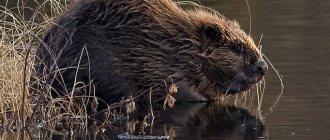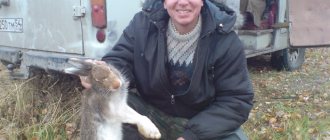What is a secret?
This word in the hunting world refers to an equipped place for observing the prey object. The main purpose of this structure is to provide comfort to the hunter and hide him from the eyes of birds. Very often, for this purpose, they build an ordinary hut from branches and grass, trying to make it so that it resembles a natural object. In an open field, skradok can be made in the form of a haystack; in water, it can be disguised as bushes or thickets of tall grasses.
Skradok
What it is
A hide is a specially equipped place for observing animals. This design is especially effective when hunting migratory birds. Its function: to hide a person from the wind, humidity and watchful duck eyes.
Most often, the hunter uses natural materials or textures that are very similar to them in order to blend into the environment. However, for each type of shelter, the specifics of preparing an ambush site are also different.
Duck hunting hides are divided into several types:
- Trench.
- Tent.
- Net.
- Shield.
The appropriate option is chosen depending on the time, weather conditions and landscape features.
Net
The simplest and most accessible type of concealment is a mesh. This camouflage is universal - depending on the time of year and hunting region, you can sew on scraps of fabric of a protective color. Sometimes grass, leaves, branches and other objects taken near the hunter’s location are placed in the mesh cells. This trick allows you to completely merge with the terrain.
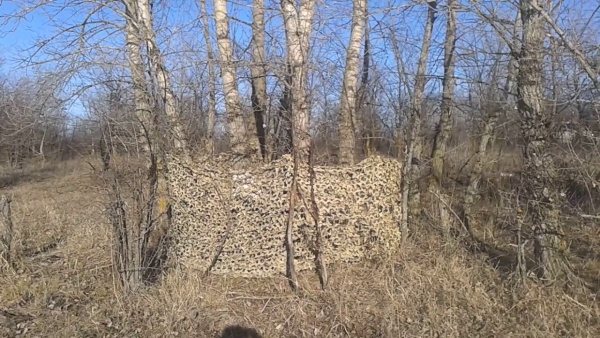
Trench
This method is indispensable when hunting ducks on the plain or near the shore of a reservoir. The depth of the trench must be at least one meter. Sometimes, if water is close, you can use grass or fabric as insulation and insulation from water, so as not to get wet during the ambush.
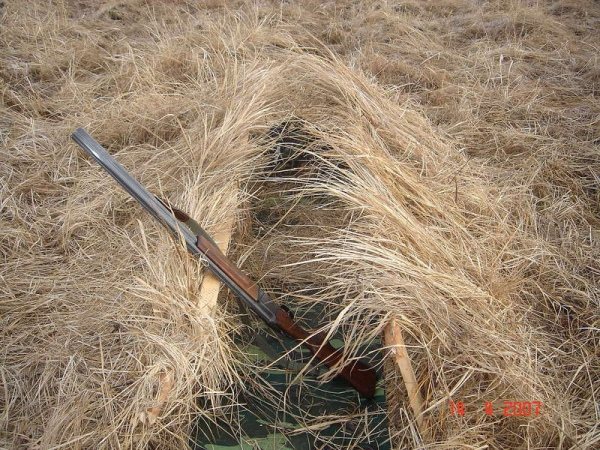
Tent
A tent is the most common type of blind for goose hunting. Another name is umbrella. It not only allows you to reliably hide from unsuspecting birds, but also protects you from rain, snow and gusts of wind. As a rule, the hut reaches a height of about a meter, as a result of which you can sit in ambush on a folding chair without sacrificing comfort.
A tent is a frame covered with thick fabric or mesh. It is suitable for hunting near water bodies and in the forest-steppe, but it should not be used in the field - the design is visible from afar and no longer serves as a camouflage device.
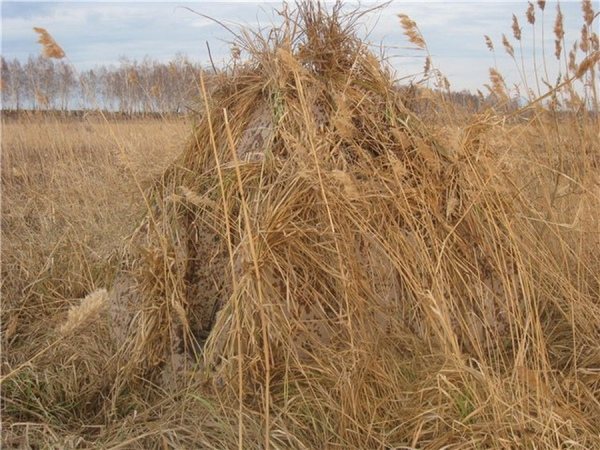
Shields
This method is popular for water hunting. The shields are made locally using natural materials and cover the hunter's boat with them.
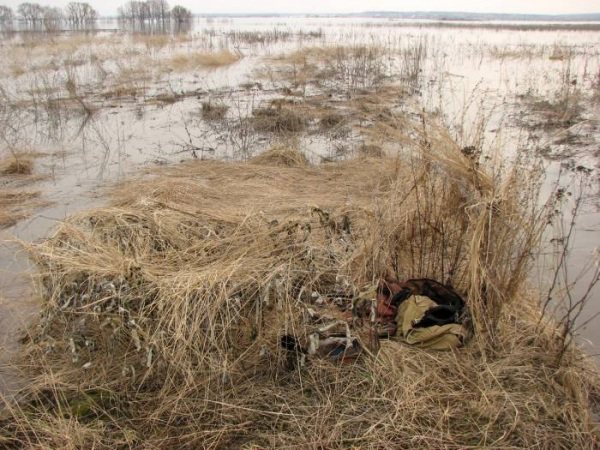
Homemade portable shelters
Now there is a large selection of industrially made concealments; their prices fluctuate greatly, but budget options are available to every buyer. However, some people do not accept artificial blinds for various reasons. Beginners rely on their own strength, while experienced hunters are accustomed to a harsh male occupation and do not take purchased plastic reeds seriously. Therefore, homemade portable shelters do not lose popularity.
In this case, the frame is assembled either from aluminum or (if the stand is designed for only one hunting trip) from durable branches. The cover is made of waterproof fabric with a protective pattern.
More often they make shelters using available materials: branches, boards, stones as support. Some craftsmen give new life to old furniture, in particular, a folding bed. It is simply placed at the hunting site and covered with camouflage netting or fabric.
Camouflage for water hunting
Duck hunting is often done using boats. In this case, the hunter remains in the open expanse of water, so it becomes much more difficult to hide. Sometimes they even use decoy birds to turn the boat into a “natural” floating hummock. It is important to consider the direction of the wind when placing natural props - the windward side should be camouflaged better.
The boat is camouflaged in two ways:
- mesh;
- shield
The mesh can be of any thickness, the main thing is a dense color so that the side of the boat does not show through. Most often, a fabric or mesh of green shades is used to resemble reeds or thickets near the shores of a reservoir. You can also use natural materials: cattails, grass, branches to completely recreate a piece of the surrounding area and disorient the bird.
Shields are most often made by hand. This requires branches, reeds and/or stems of other aquatic plants reaching more than a meter in length. Bunches of grass need to be tied with thin wire, fishing line or thick nylon thread. For security, knots should be tied in two places: at the top and bottom of the bun. The width of the shield should not exceed half a meter to make it convenient to attach and remove the structure from the side.
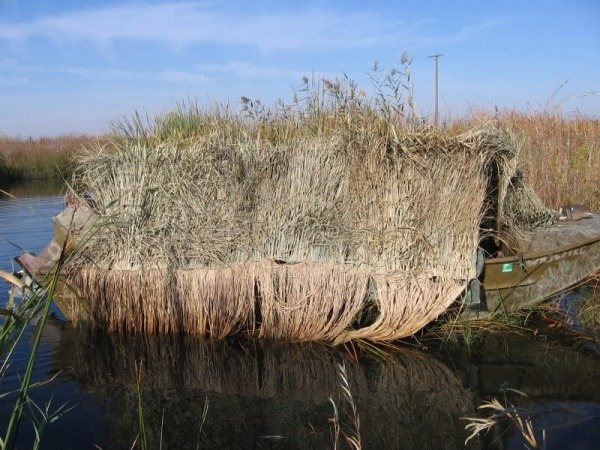
Homemade portable shelters
Professional hunters are happy to purchase ready-made industrial concealments because they are comfortable and convenient. But amateurs and beginners often think about how to make a hide for duck hunting on their own, hoping to save a lot of money. In reality, if you purchase high-quality material in a store, the cost will be almost identical to the cost of the finished model. Yes, and it will take a lot of time. The design of homemade hides is usually built by analogy with factory models. The main element is the frame . Below is a diagram of a standard frame for industrial models.
This is interesting: How to put up a tent

Everything is clear from the picture. The main task is to choose a durable and lightweight material. Plastic pipes, which are easy to install using special fasteners and soldering, could be a good choice if they have a higher load capacity. Therefore, aluminum tubes, for example, from old folding beds, are still preferable. For structural rigidity and reliability of connections, angles and bolt fastening are used. The frame is made from sections connected into a single whole using tubular locks, which makes it possible to reduce the dimensions of the disassembled product.
The cover is made from thick camouflage fabric with waterproof properties and is cut to the size of the frame. The main details are clearly visible in the figure.

This option is quite labor-intensive to manufacture and expensive in terms of materials. More often, simplified versions of homemade designs are used, using improvised means. It’s easy to repurpose an old cot by slightly modernizing it and covering the top with a camouflage net or burlap. In bad weather it will not protect from wind and rain, but in good weather it will do its job perfectly. Everyone does it to the best of their ability and imagination, trying to maximally adjust the device to their needs.
Technology for making a homemade boat
To make the simplest punt, use 3.5 m of conveyor belt or tarpaulin with a width of at least 120 cm. You will also need two boards with dimensions of 220x30x3.5 cm, they are rounded on both sides and bars are nailed to them, acting as seats and spacers. The wood is impregnated with drying oil with paraffin or wax, painted and thoroughly dried.
A belt is nailed to the end of the boards in increments of approximately 1.5 cm; moreover, a tarpaulin must first be laid on the boards. It turns out that with the help of tape the tarpaulin is tightly fixed to the wood. Spacers allow you to quickly assemble and disassemble the boat; to make the bottom more stable, you can lay plywood or flat boards in the transverse direction, joining the structure with wedges. In terms of operational characteristics, such a boat is very similar to inflatable models. When disassembled, the product fits into the trunk of a car or motorcycle sidecar.
Craftsmen make their own oared punts equipped with a sail; in this case, they provide a rudder and a lowering keel centerboard. To sew sails, dense fabrics are used - raincoat, calico, teak. The workpiece is laced to a removable mast, and a strong rail is inserted into the structure to stretch the panel.
Portable hides
Here are several descriptions of different types of factory models.
Recumbent seat DUCK EXPERT raptor
Portable hiding place
It consists of a double-sided awning, which provides the selection of the best camouflage on the terrain and pegs for quick installation. For transportation - a convenient case. Suitable for simultaneous use by two hunters. Shelter configurations range from a simple wall to a closed loop. Price 4550 rubles.
Self-expanding tent Pathfinder
Lightweight design, weighing only 2.7 kg, will protect from wind, cold, and midges. The entrance and 4 loophole windows are zipped and height adjustable. A set of pegs are included to secure it in place, and the tent itself is supported by an elastic frame, allowing for instant installation. The cost is about 6,000 rubles.
Duck hunting hides. Duck call. Duck hunting rules
With the first warmth of spring, avid hunters are overwhelmed by an incredible desire to go to the lake, lie down in the reeds and do what they love - wait for the prey to appear. Hunting for waterfowl cannot be called fast; here you have to sit or lie in ambush for hours. Moreover, in this case a person has two tasks. The first is to notice the bird in time, and the second, even more important, is to prevent it from noticing you. For this purpose, there are various duck hunting hides. You can buy them in specialized stores or make them yourself. Today we will tell you what they are, what they are for, and how to use them.
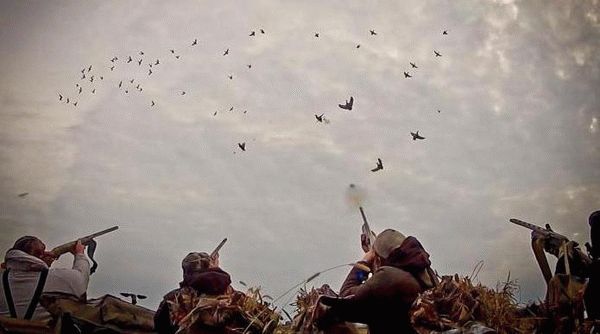
How to make a hide for goose hunting with your own hands
The design of such a product is simple, so you can make it yourself. To do this you will need the following materials:
- Metal or plastic elements for the frame of the product.
- Mesh fabric.
- Camouflage fabric or other similar material.
It is necessary that the hide does not create a large shadow, as geese are wary of this. If it is not possible to find camouflage vegetation to make a stealth, you can use a regular camouflage suit. It must be cut into pieces and placed vertically to provide a window for observation. It is recommended to mask the manufactured concealer with certain types of plants that grow in the area. Other characteristics of the hide should ensure the convenience of being in it. However, a lot of free space is not required inside the structure.
In general, the manufacturing process of this product is quite simple. You will need to first make a frame so that it is collapsible. Then cover it with masking material. There should be enough space for a person to be comfortable.
What you need to know
Hunting is a whole science. Our grandfathers used to walk through the forest for days, they knew all its paths and copses. Of course, it was much easier for them to find and shoot their prey. Today this activity has become a hobby. For many hunters, the prey is dabbling duck, mallard or teal. The habitats remain the same year after year. These are the bends of large and small rivers, ponds and lakes with abundant coastal vegetation and swamps. There are a lot of hunting methods, but only a few are popular. Although they are quite simple, to use them effectively it is important to have some knowledge about the life of ducks, in particular about their habitats, behavior and daily activity. Based on this, you can already plan your own actions.
Do not forget that there are also rules that the law dictates to us. First of all, it is important to comply with the deadlines that are set separately for each territory. Spring hunting is permitted only for drakes, for a period of no more than 15 days, from March 1 to May 10. Hunting is carried out on the basis of a permit, that is, a document that describes the shooting area and the limit on the number of hunted individuals, and the weapons allowed for use.
This is interesting: 4 simple temporary shelters: description, construction

We are building a hut
If you come to the lake without special equipment and devices, then you can get by with what nature provides. The most difficult thing is if the area around the lake is devoid of reeds and bushes, then you will have to equip a lying ambush and cover it with grass. Why such difficulties? Duck hunting hides should not stand out from the landscape. Having seen from a distance an object that was not there yesterday, the bird will not even think of flying up to the previously chosen place.

What will the finished hut look like?
It just depends on your skills and the requirements of the area. It may not even look like a classic hut, because in this case we do not need protection from the elements, but camouflage. It could be a hut or a dugout, a straw stack. The basis of the hide is the trunks of thin trees or simply branches. They are stuck into the ground in the form of a circle, and the walls are sewn up with any material that will allow them to “dissolve” in the area. The top is left open entirely or halfway so that fly-by shooting can be carried out.
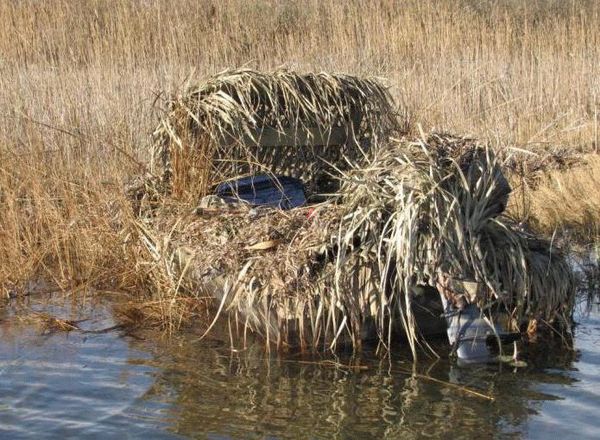
For wetlands
The most difficult conditions for an unaccustomed person. Here, a do-it-yourself hide for duck hunting is created on the basis of a raft, platform or just a hummock. The walls can be made of reeds or reeds. If conditions allow, it is better to make a convenient shelter. The hunter must be able to freely see passing ducks while remaining invisible. The size should allow you to quickly kneel down and get ready to shoot. Sitting area is another important consideration as the wait for the bird can be lengthy.
Dugout
You can dig a hide for duck hunting with your own hands in the ground. On the one hand, it is not as fast as building a hut. On the other hand, you get the opportunity to prepare a comfortable room where you can stand up to your full height, sit down, while remaining invisible. Game hunting doesn't offer much comfort, but sitting in ambush for long periods can be made a little easier.
This makes sense if you plan to make a permanent place that you will return to time after time. This is a trench or hole that should be covered with suitable material. It is imperative to leave gaps for viewing and shooting.

Choosing a blind tent for hunting
Before purchasing a blind tent, you need to understand the following parameters of the planned hunt:
• Potential desired prey.
• Terrain, natural conditions in which potential prey lives.
• The time of year in which the hunt is planned.
After this you need to select the tent parameters:
• Tent covering: mesh, camouflage fabric, branches, etc.
• Design: number of sides, windows, their location, loopholes, removable roof, etc.
• Structure weight.
• Price.
For each type of hunting you can buy a special blind tent. Or you can buy more or less universal models of such tents for hunting.
Plastic construction
This is another modification of ready-made secrets. If for you hunting waterfowl is more than a hobby for 1-2 times, then it is recommended to pay attention to this option. The basis is a frame made of plastic or aluminum tubes. It is assembled on site, like a simple construction set. Then you can act at your own discretion. This base can be simply masked - and you will have a hut. But hunting game can require hours of sitting on the shore, and weather conditions are unpredictable. To prevent rain or snow from causing so much inconvenience, hunters sew special covers from waterproof fabric. It is better to choose a gray-green color with a grassy pattern. The cape is put on the frame - and your house is ready.
This is interesting: Do-it-yourself underground house
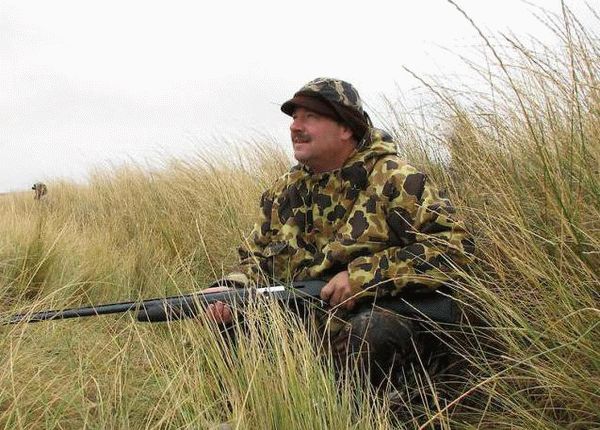
Bird hunting from a boat with a shield and net
Hunters often use decoy birds as bait - artificial or even live.
High coastal vegetation is most convenient for camouflage. If not, a net or shield is required.
The color of the mesh should approximately match the color of the coastal area. For example, swamps have greenish tints, and in autumn they are gray-straw.
Pieces of fabric of appropriate colors are pre-fixed on the mesh. Additionally, a dense camouflage of plants is created. It is good to tie the grass with wire or rope.
The sides of the boat are also densely covered with grass. It turns out to be a kind of grass cocoon, from which the hunter (or better yet, two or three people) observes and takes aim.
If shields are used as a camouflage device, it is better to make them on site from reeds.
For hunting from a boat, the net and shields are attached to the frame. Similar to how the frame is made for the tent above, it can be easily made from plastic tubes. It is usually made of four (preferably six) vertical posts connected at the top and bottom by horizontal jumpers, like a country tent. The height is determined so as to cover the person up to the chest, but not restrict the movement of the arms up and down.
Hunting fantasy is limitless. Please also offer your own examples of how to make an ambush.
Source: https://spezrezerv.ru
- Notify about new comments.
Grid camouflage
Homemade hides for duck hunting come not only in the form of a house. If you want to retain complete mobility and freedom of movement, then it makes sense to simply make a mesh - a cape that can be put directly on your clothes. For an adult, a mesh size of 3*2.5 meters will be sufficient. You can weave it yourself or buy it in a store. In addition, you will need a lightweight artificial material in the desired color. It is best to choose gray-green. But experienced hunters know well in what areas they have to spend time in ambush.
Hang the net in an open place and begin to weave prepared strips of fabric into the empty cells. The rules of duck hunting say that the hunter should not be visible from a distance of 10 meters, so weaving must be continued until objects located behind it are no longer distinguishable. Be sure to prepare a cut for the face and fasteners, with which you will secure the product to the sleeves and head. After this, you can spray paint onto the net. It is best to mix shades, take a little yellow and green, gray and black. Additionally, apply paint strokes using a brush.

How to choose?
Today, all commercially available tristands, as well as homemade tristands for hunting, can be divided into two categories – climbers and hengs. Each of them has certain advantages, which will be useful to know about in order to avoid mistakes when choosing the appropriate option. Let's talk about both in more detail.
Clymer
The climber, also known as the tristand climber. It got its name from the English word climb - to climb. Therefore, the translation “samolaz” is quite accurate. Its main advantage is the fact that the hunter gets the opportunity to climb a tree with him, or rather, with his help.
To do this, the tristand is installed at a low height (30-50 centimeters) on a suitable tree. After this, the hunter sits on the seat, facing the tree, placing his legs in special grooves. Now, alternating between raising your legs and straightening, in which you hold onto the trunk and branches with your hands, you can safely rise to the desired height. That is, no additional devices are simply needed - the climber is completely self-sufficient. The only thing that can get in the way is the branches. You will have to take a hacksaw with you to cut them down if they are too low.
The main disadvantage of the climber is its significant weight, as well as its higher price - this is due to the greater complexity of manufacturing.
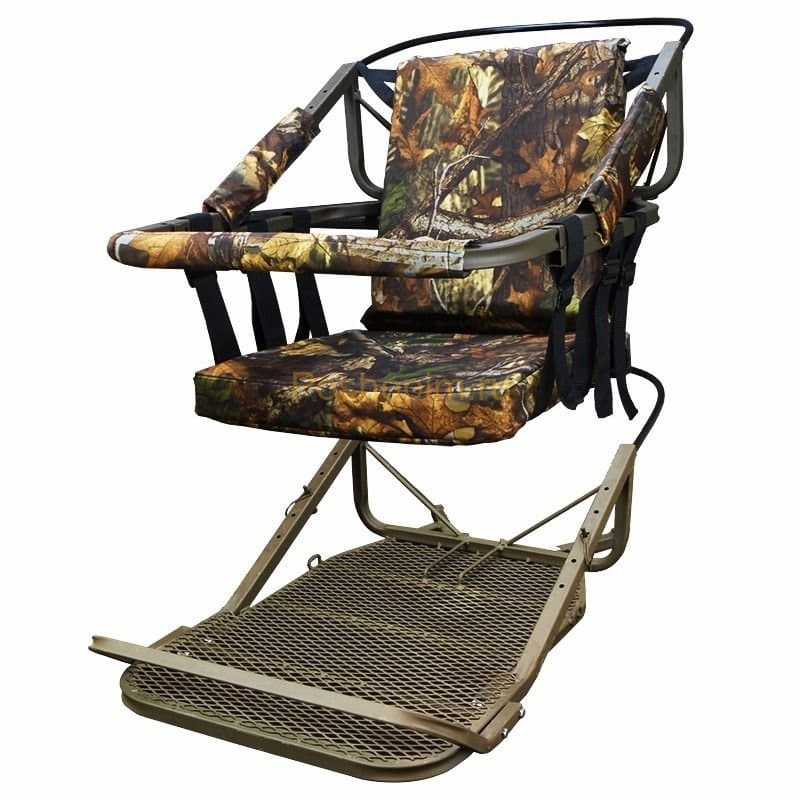
Factory-made tristand self-propelled gun
Hang
For some hunters, another type of tristand - hang (from the English hang - hang) is of considerable interest. It is a simplified version of a climber - without a lifting device. That is, in essence, it is a small storage shed made of several metal tubes and durable fabric or mesh.
The main advantage of the hang is its low cost, light weight and ease of use. However, to install it to the desired height, you will have to use auxiliary devices. This can be a ladder (but keep in mind that you will also have to carry it) or screw-in steps. The latter, although not so convenient, are much more compact and lighter. Therefore, many hunters prefer this option.
Devices - assistants
Every hunter has encountered the fact that he can make an excellent ambush and sit in it for a day, but he only sees birds flying in the distance. What to do? Quit the place and go try your luck further? In this case, duck call can help. However, keep in mind that mallards respond to it more often than drakes. Therefore, in the spring, when only the latter are allowed to shoot, such a device will be useless.
A duck call is a special pipe that can be used to turn a passing flock off course. In this case, the birds first descend, and then begin to land almost in the place where the hunter lured them. There is no need to rush now, because only one duck can fly to the call, and then others will join it. This type of hunting works best in rainy weather, early in the morning or late in the evening. Of course, such conditions are more difficult for the hunter himself, but if you have some experience, you can try.
Goose hunting from a stealth
This kind of hunting is much more difficult than duck hunting. You need to know the habits of geese, their biology, be careful and know how to properly camouflage. Typically, geese are hunted in the fall, during their migration to the winter, or in the spring, when they return to their habitats. When migrating, geese stop to rest in some places - hard-to-reach reservoirs, and feed in the same fields.
Geese belong to the duck family of waterfowl with webbed feet and serrated beaks. Birds need them to filter food from suspended water. Geese are waterfowl, but they spend little time on the water. Most of the time they are on the ground, and usually feed on plant food on the banks of reservoirs, meadows and fields.
Geese swim well, and in case of danger, they can dive. When flying, these birds can cover several thousand kilometers, and accelerate to 100 kilometers per hour if there is a tailwind. The goose wedge is similar to the crane wedge, but more ragged in shape. Typically, geese move through the air “in single file,” that is, in one line. When returning from wintering from warm regions, geese are in no hurry, and often linger in meadows and fields to feast on the first sprouts of greenery.
In Russia and neighboring countries, the most popular game for hunting are the following types of geese: white-fronted, gray and bean goose. Goose meat is highly valued in cooking because it does not have any off-flavors like other game. Therefore, it does not need to be soaked for a long time and sprinkled with spices. The taste of goose meat is delicious. Such meat was served on royal tables during holidays.
How to hunt a goose
Such an event must take into account the behavior of this game bird. To do this, you need to know the places where the geese fly, spend their days and feed. Geese feeding begins in the morning. They visit nearby fields and then fly back to the pond. The second time the geese fly in to feed is in the evening, before dark. Feeding can occur not only in fields or meadows, but also on the banks of reservoirs overgrown with lotus or water chestnut.
To install the hide, select a place where birds fly low over the ground. The hiding place should be well camouflaged with grass.
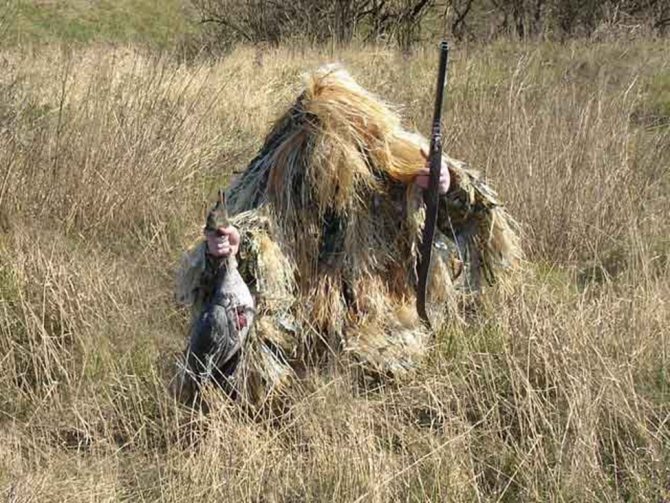
The goose is a very cautious bird; at the slightest suspicion, the entire flock immediately changes its flight direction and route. To hide, they dig a hole in the ground about a meter deep and wide, or choose inconspicuous bushes that are masked with additional elements. No foreign objects should be left near the hiding place. The hunter sits in hiding and waits for the game even before the geese arrive. Often a pair of geese come out to scout. If the flight takes place over thick grass, then you don’t have to set up a hiding place, but use the natural environment.
An important point is the correct placement of stuffed animals that attract birds. They can be purchased at hunting stores or made with your own hands. Correct installation assumes a natural appearance of stuffed animals, in the form of feeding geese. After the shot, you should not pick up the game, it will attract additional birds.
For such cases, decoy geese raised at home from wild eggs are used. They are tied near the skradka. The hunter forces them to voice. When the decoy geese see the birds flying, they will begin to call them with their voices. When goose hunting, special decoys that are commercially available are often used. Geese seem to be slow birds, but they fly quickly, and you only need to shoot at a specific goose. For a successful hunt, the weapon is configured for an accurate shot. Fractions are used No. 2 and 3.






